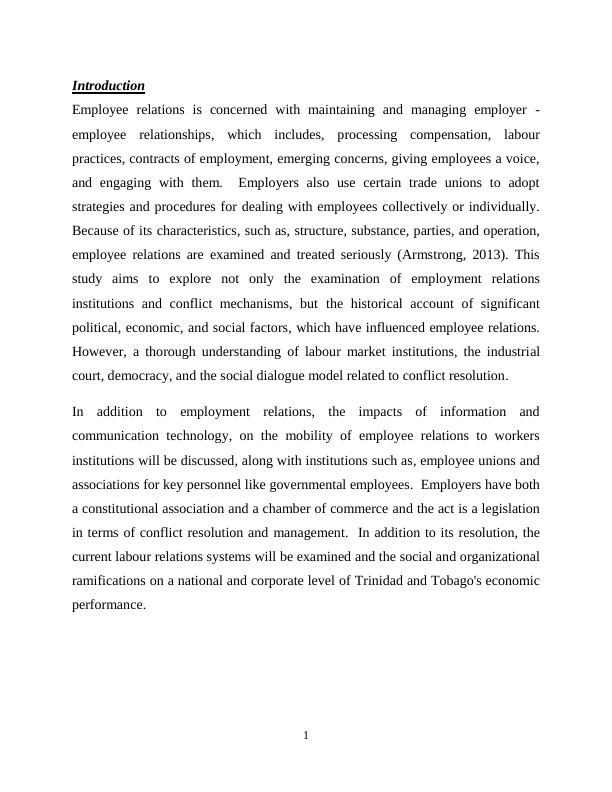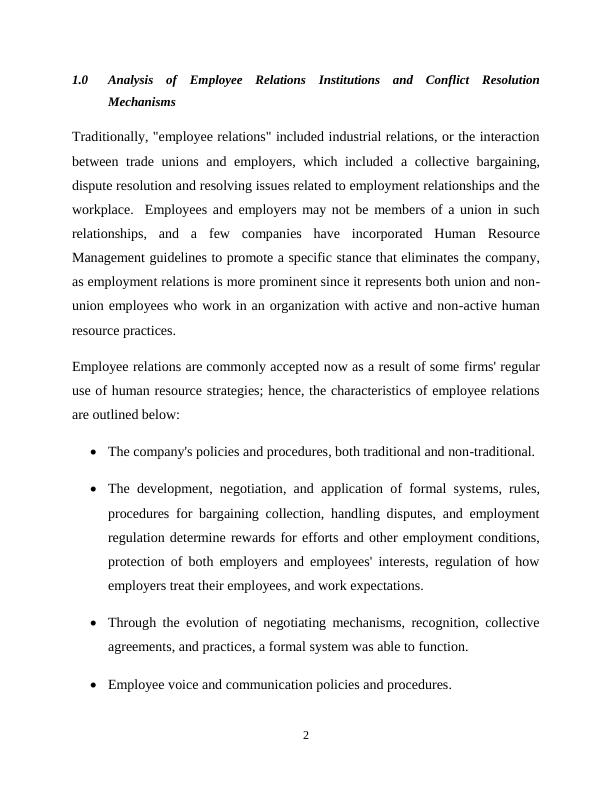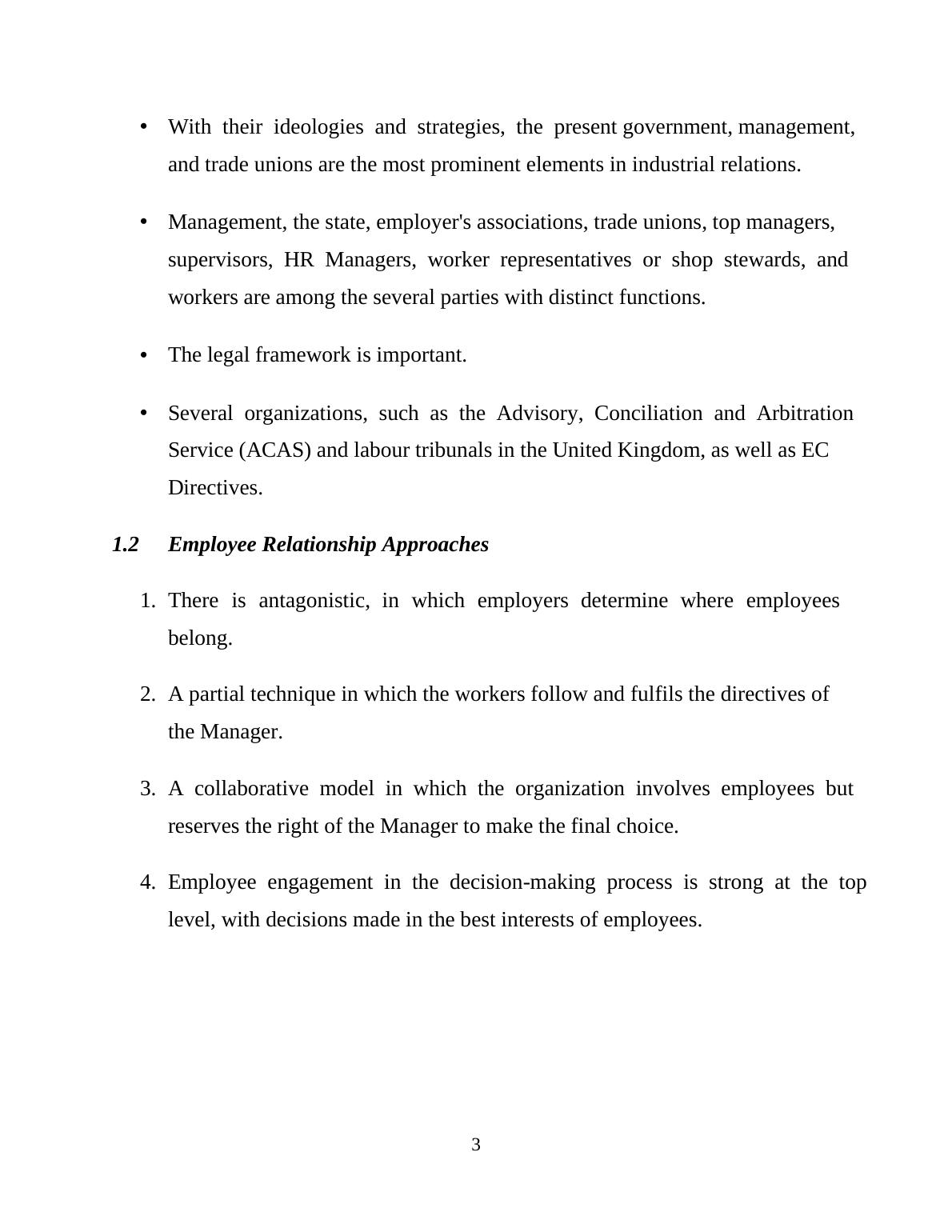Quick and Definitive - Employee Relations | Conflict Resolution
Added on 2022-07-06
15 Pages3492 Words30 Views
EMPLOYMENT RELATIONS
Element: 010 - Essay
Student ID: 1922807/1
Lecturer: Mahindra Maharaj
Date: 13th May 2022
Word Count: 3000
Element: 010 - Essay
Student ID: 1922807/1
Lecturer: Mahindra Maharaj
Date: 13th May 2022
Word Count: 3000

1
Introduction
Employee relations is concerned with maintaining and managing employer -
employee relationships, which includes, processing compensation, labour
practices, contracts of employment, emerging concerns, giving employees a voice,
and engaging with them. Employers also use certain trade unions to adopt
strategies and procedures for dealing with employees collectively or individually.
Because of its characteristics, such as, structure, substance, parties, and operation,
employee relations are examined and treated seriously (Armstrong, 2013). This
study aims to explore not only the examination of employment relations
institutions and conflict mechanisms, but the historical account of significant
political, economic, and social factors, which have influenced employee relations.
However, a thorough understanding of labour market institutions, the industrial
court, democracy, and the social dialogue model related to conflict resolution.
In addition to employment relations, the impacts of information and
communication technology, on the mobility of employee relations to workers
institutions will be discussed, along with institutions such as, employee unions and
associations for key personnel like governmental employees. Employers have both
a constitutional association and a chamber of commerce and the act is a legislation
in terms of conflict resolution and management. In addition to its resolution, the
current labour relations systems will be examined and the social and organizational
ramifications on a national and corporate level of Trinidad and Tobago's economic
performance.
Introduction
Employee relations is concerned with maintaining and managing employer -
employee relationships, which includes, processing compensation, labour
practices, contracts of employment, emerging concerns, giving employees a voice,
and engaging with them. Employers also use certain trade unions to adopt
strategies and procedures for dealing with employees collectively or individually.
Because of its characteristics, such as, structure, substance, parties, and operation,
employee relations are examined and treated seriously (Armstrong, 2013). This
study aims to explore not only the examination of employment relations
institutions and conflict mechanisms, but the historical account of significant
political, economic, and social factors, which have influenced employee relations.
However, a thorough understanding of labour market institutions, the industrial
court, democracy, and the social dialogue model related to conflict resolution.
In addition to employment relations, the impacts of information and
communication technology, on the mobility of employee relations to workers
institutions will be discussed, along with institutions such as, employee unions and
associations for key personnel like governmental employees. Employers have both
a constitutional association and a chamber of commerce and the act is a legislation
in terms of conflict resolution and management. In addition to its resolution, the
current labour relations systems will be examined and the social and organizational
ramifications on a national and corporate level of Trinidad and Tobago's economic
performance.

2
1.0 Analysis of Employee Relations Institutions and Conflict Resolution
Mechanisms
Traditionally, "employee relations" included industrial relations, or the interaction
between trade unions and employers, which included a collective bargaining,
dispute resolution and resolving issues related to employment relationships and the
workplace. Employees and employers may not be members of a union in such
relationships, and a few companies have incorporated Human Resource
Management guidelines to promote a specific stance that eliminates the company,
as employment relations is more prominent since it represents both union and non-
union employees who work in an organization with active and non-active human
resource practices.
Employee relations are commonly accepted now as a result of some firms' regular
use of human resource strategies; hence, the characteristics of employee relations
are outlined below:
• The company's policies and procedures, both traditional and non-traditional.
• The development, negotiation, and application of formal systems, rules,
procedures for bargaining collection, handling disputes, and employment
regulation determine rewards for efforts and other employment conditions,
protection of both employers and employees' interests, regulation of how
employers treat their employees, and work expectations.
• Through the evolution of negotiating mechanisms, recognition, collective
agreements, and practices, a formal system was able to function.
• Employee voice and communication policies and procedures.
1.0 Analysis of Employee Relations Institutions and Conflict Resolution
Mechanisms
Traditionally, "employee relations" included industrial relations, or the interaction
between trade unions and employers, which included a collective bargaining,
dispute resolution and resolving issues related to employment relationships and the
workplace. Employees and employers may not be members of a union in such
relationships, and a few companies have incorporated Human Resource
Management guidelines to promote a specific stance that eliminates the company,
as employment relations is more prominent since it represents both union and non-
union employees who work in an organization with active and non-active human
resource practices.
Employee relations are commonly accepted now as a result of some firms' regular
use of human resource strategies; hence, the characteristics of employee relations
are outlined below:
• The company's policies and procedures, both traditional and non-traditional.
• The development, negotiation, and application of formal systems, rules,
procedures for bargaining collection, handling disputes, and employment
regulation determine rewards for efforts and other employment conditions,
protection of both employers and employees' interests, regulation of how
employers treat their employees, and work expectations.
• Through the evolution of negotiating mechanisms, recognition, collective
agreements, and practices, a formal system was able to function.
• Employee voice and communication policies and procedures.

3
• With their ideologies and strategies, the present government, management,
and trade unions are the most prominent elements in industrial relations.
• Management, the state, employer's associations, trade unions, top managers,
supervisors, HR Managers, worker representatives or shop stewards, and
workers are among the several parties with distinct functions.
• The legal framework is important.
• Several organizations, such as the Advisory, Conciliation and Arbitration
Service (ACAS) and labour tribunals in the United Kingdom, as well as EC
Directives.
1.2 Employee Relationship Approaches
1. There is antagonistic, in which employers determine where employees
belong.
2. A partial technique in which the workers follow and fulfils the directives of
the Manager.
3. A collaborative model in which the organization involves employees but
reserves the right of the Manager to make the final choice.
4. Employee engagement in the decision-making process is strong at the top
level, with decisions made in the best interests of employees.
• With their ideologies and strategies, the present government, management,
and trade unions are the most prominent elements in industrial relations.
• Management, the state, employer's associations, trade unions, top managers,
supervisors, HR Managers, worker representatives or shop stewards, and
workers are among the several parties with distinct functions.
• The legal framework is important.
• Several organizations, such as the Advisory, Conciliation and Arbitration
Service (ACAS) and labour tribunals in the United Kingdom, as well as EC
Directives.
1.2 Employee Relationship Approaches
1. There is antagonistic, in which employers determine where employees
belong.
2. A partial technique in which the workers follow and fulfils the directives of
the Manager.
3. A collaborative model in which the organization involves employees but
reserves the right of the Manager to make the final choice.
4. Employee engagement in the decision-making process is strong at the top
level, with decisions made in the best interests of employees.

End of preview
Want to access all the pages? Upload your documents or become a member.
Related Documents
THE COLLECTIVE BARGAININGlg...
|12
|2490
|28
Introduce to Employee Relationslg...
|16
|5486
|54
Employee Relations in Tesco : Reportlg...
|17
|4338
|425
Centralised and Decentralised Bargaining: Assignmentlg...
|13
|2983
|433
Managing employee relations in UKlg...
|18
|6386
|171
Impact of Human Resource Management on Employee Relations : Reportlg...
|15
|5188
|55
